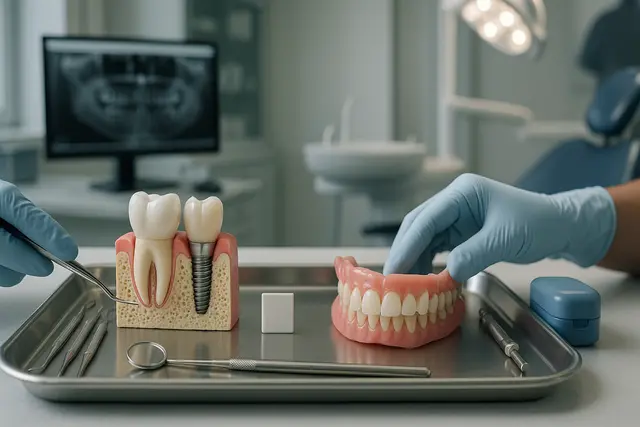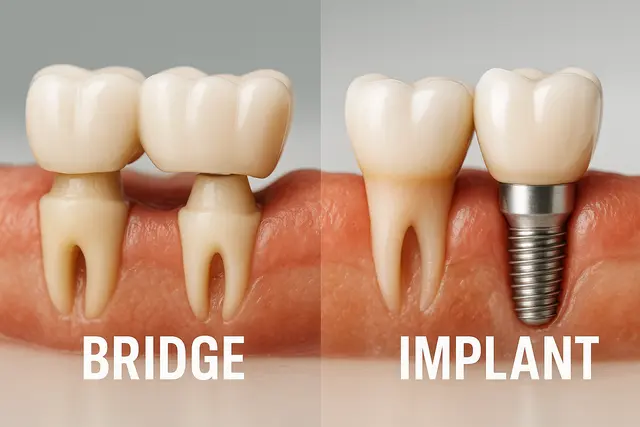Prosthodontics
5 min read
Oct 16, 2025
Implant Impression Process Explained: The Foundation of a Successful Implant
Getting a dental implant involves more than just placing a screw and topping it with a crown, it’s a carefully orchestrated process where every detail matters. One of the most critical but often overlooked steps is taking an accurate impression. This foundational step ensures your final restoration fits seamlessly, feels natural, and lasts for years.

When it comes to restoring your smile with a dental implant, there’s a lot going on behind the scenes. We’re talking precision, teamwork, and a sprinkle of dental wizardry. But one step stands out as the make-or-break moment for long-term success: the impression. It’s not glamorous, but oh, it’s essential.
So buckle up. We're about to walk through the implant impression process in a way that actually makes sense, even if the last time you thought about your teeth was during your last trip to the dentist.
Why the Impression Matters in Implant Dentistry
Imagine building a house on a crooked foundation. Not great, right? Same idea here. The impression is the foundation for the crown or prosthesis that attaches to the implant. If the impression is off, even slightly, it could throw off the entire implant restoration. And trust us, no one wants to wear a crown that doesn’t fit, literally or figuratively.
In implant dentistry, the goal is to get a perfect mold of your mouth so the dental lab can fabricate a restoration that fits like a glove. That’s where impressions come in, and there are different techniques used depending on your specific case.
What Is an Impression Coping and Why Is It Important?
If this is your first rodeo, you might be wondering, “What on earth is a impression coping?”
Here’s the impression coping definition in human-speak: it’s a tiny connector placed on the implant fixture that helps transfer its exact position, angulation, and depth into the impression. That means the dental lab can recreate your mouth precisely, even without you sitting in the chair holding your mouth open for an hour.
Taking impressions with an impression coping ensures accuracy and helps prevent future headaches (like misaligned crowns or uncomfortable bite).
Closed Tray and Open Tray Explained
Now, let’s talk trays. No, not the kind holding your lunch. In implant dentistry, trays hold the impression material and come in different styles.
In a closed tray impression, the impression coping stays in your mouth when the tray is removed. It’s a more straightforward option and often used for posterior implants or cases where space is tight. The closed tray impression technique involves placing a closed tray impression coping on the implant, taking the impression, then unscrewing the coping and placing it back into the impression later. Think of it as a dental version of precision puzzle-fitting.
An open tray impression is used when the implant position is more complex or access is easier. The tray has an opening, and the coping sticks through it. When the impression is taken, the coping remains within the impression, this can increase accuracy, especially when angulation is tricky.
The Implant Impression Process Step-by-Step
Let’s walk through the step-by-step process that takes you from post-surgical swelling to a crown-worthy grin.
Step 1: Healing Abutment Removal
Once the soft tissue has healed around the implant fixture, the clinician removes the healing abutment to expose the implant site.
Step 2: Placing the Impression Coping
A transfer cap is placed onto the implant. This impression coping aligns perfectly with the implant system and provides a direct guide for the dental lab.
Step 3: Selecting the Tray
Depending on the impression technique, the dentist or technician will use either a custom tray, a stock tray, or an open tray with an opening in the tray to accommodate the coping.
Step 4: Injecting the Impression Material
Material is used around the coping and within the tray. This could be something like polyvinyl siloxane, strong, flexible, and designed to capture even the tiniest details. Accurate impressions start here.
Step 5: Tray Placement and Setting
The impression is taken, and the material sets. If it’s a closed tray, the impression is removed carefully, and the coping remains in the mouth. If it’s open tray, the coping is unscrewed before removal.
Step 6: Repositioning the Coping in the Impression (Closed Tray Only)
Once the impression is out, the impression coping is unscrewed and repositioned within the impression. This part requires skill, because the position must be perfect to replicate the implant site accurately.
Step 7: Analog Attachment and Lab Time
An analog is attached to the coping within the impression, mimicking the implant. The impression heads to the dental laboratory, where technicians work their magic using the model to fabricate your crown, denture, or other implant-supported prosthesis.
Choosing the Right Impression Technique
So, how does your dentist pick between closed tray and open tray? It depends on the implant components involved, how deep the implant is, the angle, and what the final restoration will be.
Closed tray impression: Ideal for single-unit implants or where space is tight.
Open tray impression: Better for complex angulations or multiple implants.
The goal in both is clear: capturing the exact position of the implant abutment or fixture so the restoration fits comfortably and securely.
Implant Components and Why They Matter
Let’s give a shoutout to the unsung heroes: the implant components. These include the implant fixture (what’s placed in the bone), the abutment (which connects the crown to the implant), and the crown or prosthesis itself.
Each component plays a role, and they have to work in harmony. A poorly aligned abutment can make the crown look off, feel weird, or worse, fail. That’s why the implant impression stage has to be flawless.
The Role of the Dental Lab and Technician
Once your impression gets to the dental lab, that’s when the behind-the-scenes craftsmanship kicks in. The technician pours a model, attaches the analog, and builds a replica of your mouth. Using zirconia, titanium, or alloy materials, they fabricate your custom restoration with the kind of attention to detail that borders on obsessive.
And that’s a good thing, especially when it comes to something living in your mouth full-time.
Why Impressions with an Impression Coping Aren’t Just Routine
For clinicians, impressions with an impression coping are a daily task. But for patients, it’s an essential step that decides whether your implant will feel like a natural tooth or a foreign object.
Even in digital impression systems, scan bodies are used in place of physical copings. But the principles remain: position, angulation, and soft tissue detail matter.
The Final Restoration and Crown Installation
At last, the final restoration stage. Once the lab finishes fabrication, your dentist checks the fit, makes sure your bite feels natural, and installs the crown. Whether it’s screw-retained or cemented, this crown marks the end of the implant process and the beginning of a better bite.
Implant prosthodontics isn’t just about filling space, it’s about restoring confidence, function, and esthetic appeal. And that all starts with getting the impression right.
What Is the Implant Impression Process and Why Is It Important?
The implant impression process involves creating an accurate mold of your mouth to guide the fabrication of your final dental restoration. It ensures that the crown, bridge, or denture fits precisely on the implant, aligning with your bite and surrounding structures. A poorly taken impression can result in discomfort, improper bite alignment, or restoration failure. This step forms the foundation of a successful, long-lasting implant outcome.
What Is an Impression Coping and How Does It Work?
An impression coping is a small connector temporarily placed onto the implant during the impression process. It transfers the exact position, angulation, and depth of the implant to the dental impression. This enables the dental lab to create a restoration that perfectly matches your unique implant placement, without needing your physical presence. It's a key component for ensuring precision and avoiding fit issues later.
What’s the Difference Between Closed Tray and Open Tray Impressions?
Closed tray impressions are used when space is limited or when dealing with a single implant. The coping stays in the mouth when the tray is removed and is repositioned into the impression afterward. Open tray impressions are better for multiple implants or complex angulations; the coping extends through a hole in the tray and is removed together with the impression. Each method is chosen based on access, accuracy needs, and implant location.
What Happens After the Impression Is Taken?
Once the impression is captured, the coping is either repositioned (closed tray) or already embedded (open tray), and an analog is attached to mimic the implant. The impression is sent to the dental lab, where technicians pour a model and fabricate the final prosthesis, typically a crown, bridge, or denture. The dentist later checks the fit and installs the final restoration, ensuring it feels natural and functions properly.
Read Next
Related Posts

Prosthodontics
Implant vs. Dentures Pros and Cons: A Deep Dive into Modern Solutions
Missing teeth can impact more than just your smile, they can affect how you eat, speak, and feel about yourself. Fortunately, modern dentistry offers two leading solutions to bring back both function and confidence: dentures and dental implants. Understanding the pros and cons of each can help you make the choice that fits your needs, lifestyle, and budget.
7 min read
Oct 17, 2025

Prosthodontics
Full Mouth Implants vs. Dentures: Which Is Better for You?
When it comes to replacing missing teeth, the choice between full mouth dental implants and dentures can be overwhelming. Each option has its own set of benefits, limitations, and long-term considerations, making it essential to understand what works best for your needs, health, and lifestyle.
5 min read
Oct 17, 2025

Prosthodontics
Tooth-Supported Bridge vs. Implant Comparison: Benefits, Drawbacks, and Insights
Deciding between a dental bridge and a dental implant can feel overwhelming, especially when both options promise to restore your smile and improve oral function. Each solution comes with its own set of benefits, considerations, and ideal use cases, making it essential to understand how they compare before choosing what’s right for you.
6 min read
Oct 17, 2025
Don’t have time to research every dentist around you?
See why 30k+ patients trusted us